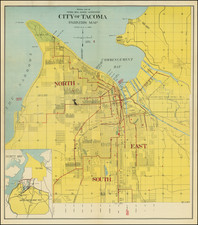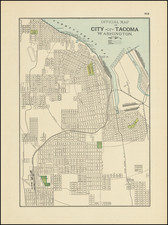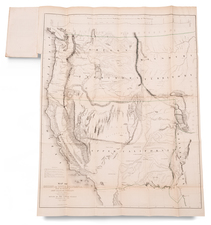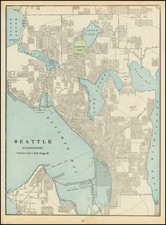Mining For Gold East of Seattle in the Blewett District / Chelan County at the end of the 19th Century
Detailed map of the mining regions south of Peshastin and Leavenworth in the Blewitt District, at the height of the region's mining boom.
The region shown is south of the Wenatchee River, with the mining claims appearing on Peshastin Creek, Ruby Creek, Falls Creek and Negro Creek.
The Blewett Stamp Mills are shown on Peshastin Creek, with a wagon road extending south toward the area labeled Placer Mines. The key indicates that the area was being mined for Gold, Copper and Nickel.
Chelan County Gold
Rich gold placers were discovered on Peshastin Creek in 1860 and were worked intermittently for several years. In 1874 vein deposits were found in Culver Gulch. For many years only the oxidized parts of the veins were mined, but in the late 1890's extensive development revealed new and rich ore bodies and for a while the district prospered. After 1910, however, there was only small-scale activity. Total production from 1870 to 1959 was approximately 850,900 ounces.
Blueprint maps
Blueprint maps were among the most popular means for the swift printing of maps for which there would be a limited demand. A blueprint map could be made and/or revised much more quickly than a lithograph, cerograph, or other printing method, and at a much lower cost.
Blueprinting as a method was invented in 1842 by John Herschel, a chemist, astronomer, and photographer. A cyanotype process, one starts by drawing on semi-transparent paper, weighted down by a top sheet of paper. The paper would be coated with a photosensitive chemical mixture of potassium ferricyanogen and ferric ammonium citrate. The paper would then be exposed to light, wherein the exposed portions turned blue and the drawn lines, protected from exposure, would remain white.
The blueprint process was an improvement on the expensive and time-consuming method of hand-tracing original documents. The technique was particularly popular with architects; by the 1890s, a blueprint was one-tenth the cost of a hand-traced reproduction. It could also be copied more quickly.
Blueprint maps began to appear as early as the 1850s and 1860s, but they really began to become the standard for mining and similar limited-purpose maps by the 1880s. The ability to create these maps quickly and at a low cost made them the standard for short-run prints, ideal for mapping mining regions in the West and for similar purposes.
The method still exists today, but in a very limited fashion. In the 1940s, diazo prints (whiteprints or bluelines) became more popular, as they were easier to read and faster to make. The blue lines on a white background of these prints are now what most people call blueprints.
Rarity
The map is apparently a unique survival. We were unable to locate any other examples of the map.












![[Alaska to San Diego and San Qunitin, British Columbia] A Chart Shewing Part of the Coast of N.W. America, with the Tracks of His Majesty's Sloop Discovery and Armed Tender Chatham . . . (First Modern Map of the West Coast of North America)](https://storage.googleapis.com/raremaps/img/small/102067.jpg)
![[ Pacific Coast Pictorial Road Maps ] Scenic Touring Scout](https://storage.googleapis.com/raremaps/img/small/101745.jpg)
